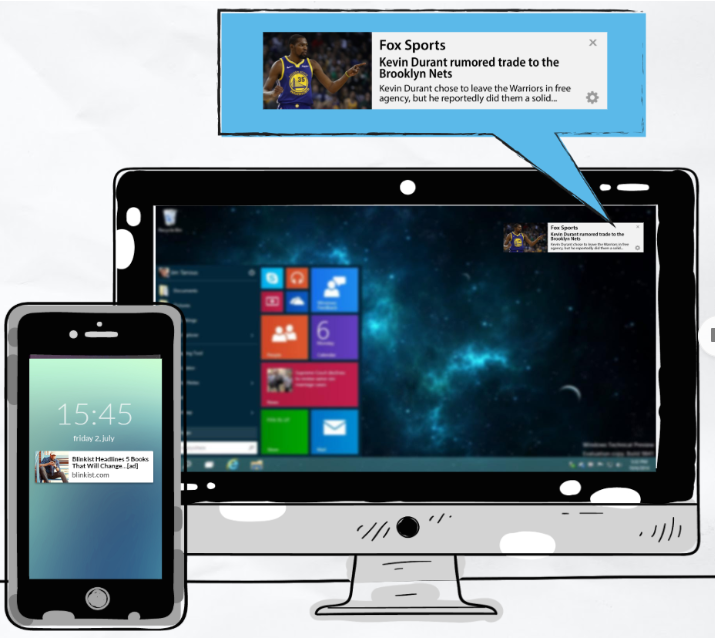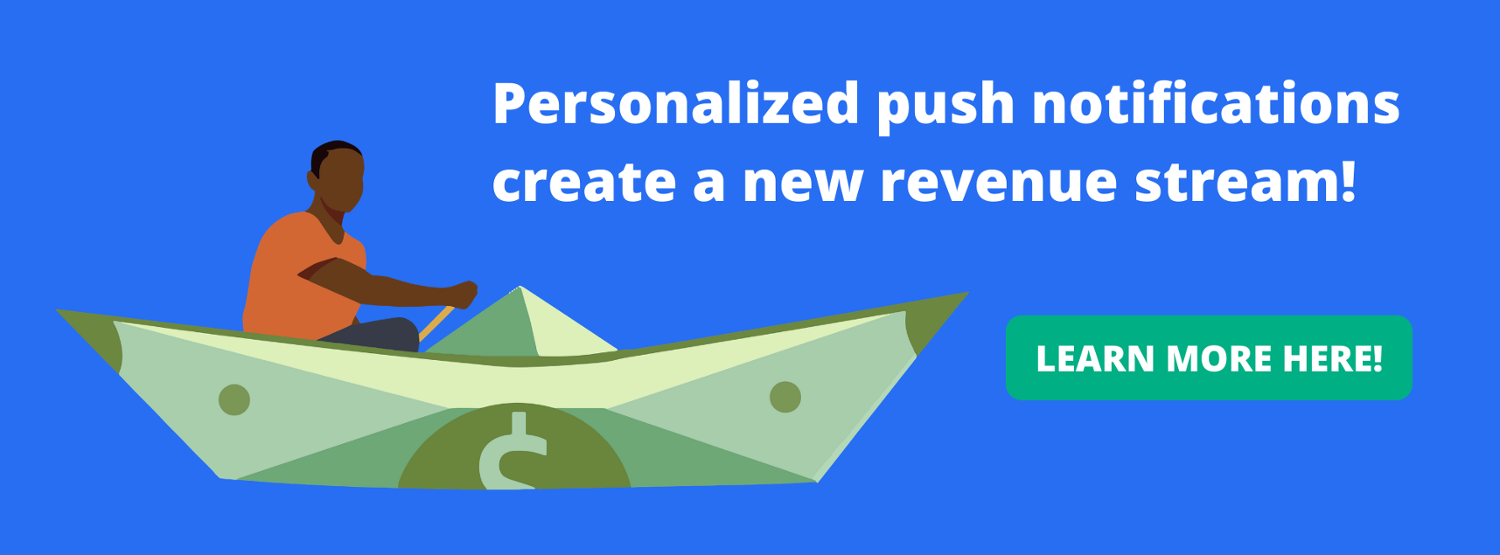Push notifications are an ideal way to break through online clutter and competition to connect directly with the consumer. But as with all marketing methods, there’s a time and place for this technology, and overusing it or using it at the wrong time can alienate your audience.
Here’s what you need to know about creating a push marketing strategy so you can advertise to and connect with your audience — and how to keep those connections high-quality so consumers don’t block you.
What Are Push Message Notifications?
Push message notifications can occur in both mobile (Android) and desktop environments.
On mobile devices, push notifications are small messages that pop up on the screen to inform the user about content or updates, even when the associated application is closed. The specific way push marketing works on a mobile device tends to depend on the user’s settings: Some push notifications appear as screen pop-ups, others are drop-downs from the top of the screen. Some users set message notifications to appear over the lock screen, while others don’t.
The concept of web push alerts is the same on desktop devices. They appear as a clickable pop-up, usually in the bottom left or right corner of the screen. Depending on the technology behind your push message notifications or how the user has them installed, the pop-ups may occur no matter what applications are open or may only work when the user has opened a specific internet browser, such as Chrome.
In either case, the person has to click or tap on the app notification to open the related app and view the content presented by your push marketing campaign.
How Does Push Marketing Work on Technology?
Push notifications work in a slightly varied way according to what type of device they’re being seen on, user settings and the technology you’re using to make the push. But they follow the same basic premise, which is outlined below.
- The publisher chooses an option (service) for delivering push alerts.
- The publisher creates an opt-in for push notifications; you usually offer this when someone downloads your app, visits your site for the first time or signs up for a newsletter or other service.
- Users opt-in to receive push alerts — a critical step before you can start sending things. Otherwise, you risk crossing lines of legality, and you definitely annoy consumers. On Apple devices, opt-in is always manual. On Android devices, many apps work via passive opt-in, which means the opt-in is included when the user downloads the device. Because of this, Android users are around twice as likely to use notification alerts as iOS users.
- Once permission is provided, you can publish push notifications to let users know about new content, new offers or other information.
Depending on how the user sets them up and what options are offered, push marketing notifications can:
- Display a message on the screen
- Display an icon or drop-down option that users must click on to get the message
- Cause an audible notification, such as a chime or alarm
- Cause a mobile device to vibrate
- Display only when a certain application is open
Because of these variables, setting up a push promotional strategy requires care and precision. When done right, this type of push marketing strategy diversifies your brand’s reach.
What Are the Benefits of Push Marketing?
A push marketing strategy can be beneficial for both brands and consumers.
Apart from general brand awareness, there are 3 main benefits of push marketing:
- A direct connection to the consumer. With social media and search results governed by powerful algorithms that don’t always play in your favor, the ability to cut straight to the chase and ping a person’s phone is huge.
- The chance to get news to consumers fast. Planning a flash sale, launching a new product or service, or do you have important news about an upcoming event? Push marketing alerts help ensure your customers see the information in a timely manner.
- Building a significant relationship with the consumer. When push marketing notifications are handled correctly, they can help you build a relationship with the customer. They may come to rely on your notifications for certain information or to manage a process or function related to your product or service. You could even re-engage past website visitors. That’s a great position to be in as a brand.
On the flip side, the benefits of push marketing for consumers include:
- Easy access to important information without sorting through everything. The internet gets up to 2.5 quintillion bytes of data added every day — the amount of data the world generates is so huge, we have to use an unfamiliar-sounding number to describe it! And while consumers only view a tiny fraction of this information, the amount of data available to them can be overwhelming. Push notifications make it easy to prioritize information in an automated way.
- Not missing important updates. Consumers may opt to receive notifications about events, sales, new product releases, or blog updates so they don’t miss out on anything.
- Increased functionality of apps. Many apps allow consumers to configure notifications that let them know it’s time to take action or remind them when they haven’t done something for a while. This can help consumers organize their use of apps.
Check out what our CEO, Jeff Kupietzky, has to say about notifications in this video:
What is the Difference Between Push and Pull Marketing?
While both can be beneficial to your overall marketing strategy, the main difference between push and pull marketing is in how audiences are provided content. With push marketing, you can promote products and content by delivering them directly to people across various channels — think, browser-based, email or mobile push messages. The content is placed in front of subscribers on the channel where they are most likely to engage with it. In pull marketing, however, it is the other way around. Companies need to draw consumers to the products, usually via long-form content like blog posts, byline articles, etc. which they will find organically online.
Basically, push and pull marketing have the same goal for your promotional strategy but are going about it in opposite ways. Push marketing proactively presents the product or advertisement to the target audience. Pull marketing, on the other hand, takes on more of an inbound approach by attracting the consumer to the product in a more seemingly passive way.
When Should You Use Push Marketing Notifications?
It’s not all benefits and hurrahs when it comes to push marketing strategies, In an article for Wired, David Pierce rants against the constant intrusion too many push alerts can have on his day. For this reason, you have to be careful how you develop your push marketing strategy, or else your audience will disable the alerts.
Here are some tips for when and how to use push notifications to ensure a greater chance of success.
- Provide custom options so consumers can decide when they get ad alerts. Consider the eBay app, which allows users to request updates when very specific products are listed for sale. It’s unlikely someone would want a push alert every time an auction is listed, but they may want to know whenever a specific Denon CD player is listed.
- Don’t use push alerts for every update or function. If users are getting many updates a day from you, they’re unlikely to pay attention to them in the long run. Try to use ad alerts for the most imperative communications or helpful functions. How many updates you can get away with daily does depend on the age of your app and what type it is, so you do need to test. Start with fewer apps and build up from there to determine where the best performance is found and what the tolerance for push notifications is among your audience.
- Do some research to determine what times promotional advertising is most effective for your brand. According to Accengage, notification alerts tend to have the highest email open rates on Tuesdays, and updates during nonworking hours tend to perform better.
- Don’t forget about time zones when you’re programming push alerts. It’s a good idea whenever possible to partition your list into time zones so you can send push emails out at appropriate times because one thing that’s sure to alienate a user is being awakened at 3 AM every morning by your promotional update.
In conclusion, giving your customers control and keeping content relevant makes for a more successful and inclusive marketing strategy.
Examples of Push Marketing Notifications
When creating your push marketing strategy, you should think of it in terms of multichannel messaging. You should provide the right content at the right time on the channels where your audience members prefer to receive the notifications.
For example, let’s say you’re running a news portal with sections for Technology, Politics, Entertainment, Sports, and Science. One person might prefer to receive Technology news as a mobile notification during their lunch break, while another person wants to get web notifications about Entertainment news during their morning coffee. Meanwhile, another person might prefer to receive Politics and Technology news stories in their email in the late afternoon.

Most people think about pop-ups on mobile phones when they think of push notifications. But they are so much more than that. When developing your push marketing strategy remember to consider all the channels where your audience is active and their unique user preferences.
What Else Do Publishers Need to Know About Push Messages?
When it comes to crafting your push message, know that shorter is better. According to Localytics, push notification messages under 10 words have higher-on-average click-through rates than longer messages.
- 10 words or less — 8.8 percent CTR
- 11 to 20 words — 4.9 percent CTR
- 21 words or more — 3.2 percent CTR
The copy itself is also important. Even though the user subscribed to the message notifications at some point, keep in mind the clutter that can develop on a mobile device. Users get many push notifications, so yours needs to stand out, be clear and hopefully remind the user about your brand. Try to craft creative copy that provides an action-oriented message that ties to your brand. This is key to an effective marketing strategy.
- No: Time to sign into your account.
- Better: Sign into ShopShop for 50% off now.
- No: New message for you.
- Better: Stephanie contacted you on FriendApp; see the message now.
Ten words aren’t much, but they’re plenty if you’re careful about the message. Try to include the who, what, and why with a soft or hard call to click. You have to make the person care enough to click or tap to find out more.
Finally, for an optimized push promotional strategy, customize your message notifications in any way possible. This is not a one-size-fits-all technology. A push notification pops up on a mobile device a lot like a text from a friend might. And even though it’s not a text, personalization can help the consumer see it in the same light, making it something to look forward to, look at right away or respond to proactively.
Make a Push Marketing Strategy That Works for You
Finding an automated way to gather audience data, parse it, and create and send personalized messages across channels is crucial for a successful push strategy. Jeeng’s push monetization features let you score even more value and revenue from push marketing.
Reliable ad placement in push notifications all but guarantees monetization, and our smart automated approach lets advertisers target specific users with less work. Whether you’re a publisher looking to increase the ROI on connections or an advertiser in search of more opportunities to get placed in front of the right audiences, Jeeng can supercharge your push marketing strategy.
For example, what attracted GoGy to Jeeng’s push marketing tools was that Jeeng’s machine-learning solution automatically delivers very relevant, personalized and targeted notifications with the intention of increasing user engagement. As a gaming platform accessed by users across the globe, GoGy needed a platform that allows push marketing customization across time zones. Sending relevant notifications means that push marketing campaigns work to captivate audiences, growing the attention without bombarding users.
Now, let’s take a look at another example. Push marketing helped 200-year-old publication Farmers’ Almanac reinvent itself when they began to send one monetized push and one organic push notification daily. The result was more traffic and revenue. Riding on the successes of this push marketing strategy, Farmers’ Almanac added newsletter monetization to the mix. As an extension of the push marketing strategy, the company used Jeeng’s automated algorithms to load those newsletters with topical and relevant content for readers. Here’s how Farmers’ Almanac’s Digital marketing manager Frank Pagano explained it:
“Because we’re able to send content that caters to a readers’ particular interests, instead of generic batch-and-blast emails, our click-thru rates and traffic on our website have both increased. Plus, we can track what each user engages with, and what they don’t, to continuously refine our content recommendations and timing. No other service provider offers this capability, and it’s become one of our most stable revenue streams, boosting revenue from email and push alone by 110% a month.”
Interested in seeing similar results? Contact Jeeng today for more information on intelligent, automated ad approaches that drive up revenue without alienating your audience. You can also download our eBook to learn more about push notifications and how they drive new revenue for publishers.





